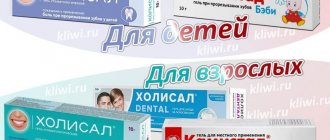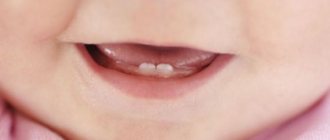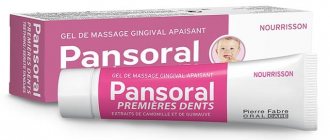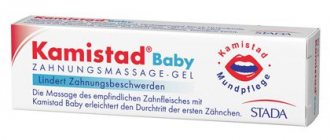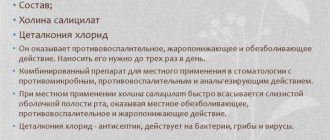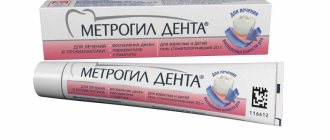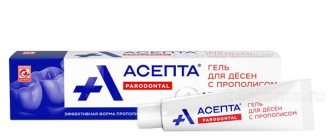Treatment of stomatitis in children: remedies and preparations
When choosing a remedy for the treatment of oral cavity for stomatitis, be sure to consult a doctor and treat this responsibly. After all, the use of a drug intended for the treatment of adults can cause an overdose or adverse reactions in a child.
To relieve pain from ulcers and wounds during a child’s illness, you should use medications that are given to infants during teething.
Aekol. The drug is prescribed for childhood stomatitis at any age to treat ulcers, since its use promotes effective healing of the child’s oral mucosa. Directions for use: during treatment, apply to affected areas every other day, use until complete healing. Gel Kamistad. The drug is a mass used to treat stomatitis by achieving an analgesic, antimicrobial, anti-inflammatory effect. The substance lidocaine included in the drug anesthetizes, reduces pain, and natural chamomile extract gently relieves inflammation and regenerates the mucous membranes of the child’s oral cavity. Directions for use: Squeeze the gel locally onto the affected areas and rub in without pressing until completely absorbed. Use three times a day until stomatitis completely resolves. Contraindications apply to pregnant and lactating women. Spray Miramistin. The local oral disinfectant Miramistin has a spray nozzle, which allows the drug to be used by children even under one year of age. The drug works well against microbes, the herpes virus. Directions for use: treat diseased areas in the mouth using a special attachment up to 4 times a day. Use the drug for a week. Lugol's solution. Lugol's preparation with a high content of iodine is used to lubricate the pharynx and oral cavity in infectious and inflammatory diseases, including childhood stomatitis. The solution has a local irritant, antifungal, disinfectant effect, helps get rid of many gram-negative and gram-positive bacterial organisms that cause stomatitis. Directions for use: rinse painful areas of the mouth with Lugol's solution up to 6 times a day, for children - 2-3 times a day. Treatment is continued for up to 3 days. The children's drug is produced in the form of a spray.
Long-term use of Lugol's solution may be accompanied by side effects in a child (runny nose, dry skin, allergic manifestations, nausea, vomiting). Should not be used if you have high iodine sensitivity. Candide. A wide spectrum of action against fungi is a distinctive feature of Candida. It leads to the destruction of cells of various types of fungi inhabiting the human body. High efficiency and low degree of absorption allow the drug to be used for the treatment of childhood stomatitis. Directions for use: apply the ointment to fungal-affected areas of the child’s mouth using a cotton swab. Already on day 3, the condition of the mucous membranes will improve significantly, but it is recommended to use the cream until the patient has completely recovered.
- < Back
- Forward >
Kamistad
Kamistad is an original medicine from a German pharmaceutical company, used in dental practice to relieve pain due to inflammation of the mucous membrane of the mouth and lips. It has anti-inflammatory, antimicrobial and local analgesic effects. The drug contains two pharmacologically active components: lidocaine and liquid extract from chamomile flowers. Lidocaine is a powerful local anesthetic whose action is based on suppressing the penetration of sodium ions into nerve fibers. Compared to novocaine, it acts longer and is better tolerated by patients. In addition, studies have confirmed the antimicrobial properties of lidocaine. Chamomile flower extract includes a complex of various substances of natural origin that provide effective disinfection, wound healing and reduction of inflammation. At the same time, the most important medicinal substances are sesquiterpenes, of which this extract contains almost half of the total amount.
Kamistad has proven itself well in clinical trials, some of which were carried out by domestic specialists. One such study was conducted at the Samara Medical Institute. It involved patients suffering from infectious-allergic diseases of the oral mucosa and developing erosive syndrome. The drug was prescribed in the form of a gel application. The gel was applied three times a day for 5-6 days.
During the study, all the undeniable advantages of kamistad were fully demonstrated. Thus, the drug quickly and for a long time had an analgesic effect. Persistent anesthesia was sufficient to perform all necessary dental procedures and significantly improve the patient's condition. In addition, the drug exhibited a pronounced anti-inflammatory effect, disinfected the wound surface well (against the background of its action, a 2-fold decrease in the microbial number was noted) and activated the restoration of the epithelium. The study participants showed a much faster disappearance of signs of inflammation (pain, swelling, hyperemia, unpleasant odor and fibrinolytic plaque) and normalization of the functions of the oral mucosa (salivation, epithelization and phagocytic reaction), which dentists abbreviate as " SOPR". The experience of using the drug Kamistad eloquently demonstrates its high effectiveness in the treatment of inflammatory diseases of the oral mucosa of infectious-allergic etiology and a favorable safety profile. Thus, the reliable analgesic effect of the drug, the natural antiseptic component, which eliminates the need for additional “chemicalization” of the body with drugs of synthetic origin, as well as good tolerability, allow it to be used both in an outpatient setting (for example, in a dental office) and independently.
Stomatitis
Stomatitis is the most common lesion of the oral mucosa.
The mechanism of stomatitis is associated with the reaction of the immune system to irritants. It is believed that stomatitis occurs in cases where, for reasons that are not yet clear, the human immune system reacts to the appearance of molecules that it cannot recognize. The appearance of such molecules provokes an attack by the lymphocytes of the immune system (a type of white blood cell), in much the same way that the human immune system reacts, for example, to an organ transplant. The “attack” of lymphocytes on these unidentified molecules leads to the appearance of ulcerative formations in the mouth, which are called “stomatitis”. With stomatitis, patients complain of burning of the oral mucosa; pain when eating and talking; “ulcers” in the mouth. In some cases there may be an increase in body temperature, an increase in regional lymph nodes.
The causes of stomatitis also include:
Insufficient or excessive oral hygiene;
Thermal, mechanical, chemical injuries. Most often, minor injuries heal on their own. But under unfavorable factors, stomatitis may develop
Diseases of the gastrointestinal tract, such as gastritis, duodenitis, colitis, as well as helminthic infestation, can cause catarrhal stomatitis.
Various infectious disease agents have been implicated in the development of oral ulcers. Normally, opportunistic bacteria are constantly present in the mucous membrane of the oropharynx and do not cause irritation. For their reproduction, additional unfavorable factors are needed: mechanical or thermal damage to the oral cavity,
Dehydration caused by diarrhea, vomiting, insufficient water intake, prolonged increase in body temperature, increased urine output, large blood loss
Poorly made dentures
The use of medications that reduce salivation
Anemia
Vitamin deficiencies, lack of iron or folic acid
Malignant tumors in the neck, nose or throat
Hormonal fluctuations during pregnancy, menopause, and adolescence.
Side effects of chemotherapy
HIV infection, tuberculosis, diabetes mellitus, bronchial asthma.
Toothpastes and mouth cleaners containing sodium lauryl sulfate (SLS) This is likely due to the fact that SLS has a dehydrating effect on the oral mucosa. Therefore, it becomes more defenseless to various irritants.
Types of stomatitis
Allergic
Currently, many people have any allergic reactions to a wide variety of substances: food, medicines, pollen, animal hair, house and library dust, etc. This type of stomatitis is not considered as a separate disease, since it is only part general allergic manifestations. Treatment comes down to eliminating the allergen, taking antihistamines. An allergy to dental plastic may also occur if there are removable structures in the oral cavity. With this type of stomatitis (prosthetic stomatitis), adequate re-prosthetics is recommended.
Aphthous
Aphthae are small superficial ulcerations of the mucous membranes of an oval or round shape. An inflamed red rim appears around this ulcer, a thin white film forms in the center, and the edges of the ulcer are smooth.
In addition to the ulcer itself, which is very painful, a person is bothered by increased salivation, bad breath and bleeding gums
Oral aphthae are accompanied by pain that makes chewing and speech difficult, excessive salivation, and enlarged submandibular lymph nodes. After 5-7 days they heal without scar formation.
Herpetic
This type of stomatitis is caused by various viruses. This could be the chickenpox virus, the influenza virus, or adenoviruses. Among them, the herpes simplex virus is the leader in the frequency of lesions of the oral mucosa. The majority of the adult population is a carrier of the herpes virus. It remains in the body in a dormant state, without causing any discomfort or causing diseases.
But, if there is a decrease in the body’s defenses, stress, overwork, exacerbation of chronic diseases, the virus can become more active and manifest itself in the form of recurrent herpetic stomatitis,
With herpetic stomatitis in adults, there is usually no acute reaction of the body, such as an increase in body temperature, symptoms of general intoxication, etc.
Candida
This type of stomatitis occurs mainly only in very weakened people, in HIV-infected people, in patients with tuberculosis, in patients using steroid hormones. The causative agent of thrush in the mouth is the Candida fungus, which is always present in the oral cavity normally, but under unfavorable factors it begins to actively multiply.
A peculiarity of this stomatitis is that a cheesy coating first appears on the mucous membrane, which, when removed, forms a swollen, reddened inflammatory focus. Painful erosions can also form under the plaque film. Fungal stomatitis is characterized by dry mouth, catching, cracks in the corners of the mouth, burning and pain while eating.
Traumatic
This type of stomatitis is caused by traumatic factors that may be present in the patient’s oral cavity. Sharp edges of carious teeth and poorly made orthopedic structures can lead to the appearance of traumatic stomatitis.
Ulcerative.
Ulcerative stomatitis can be a complication of aphthous stomatitis. With a decrease in the general resistance of the body, with a deficiency of vitamins, stomatitis can be complicated by fusospirochetosis and proceeds as ulcerative-necrotic. In this form of the disease, the ulcers are covered with a greenish-gray foul-smelling coating. The patient's general condition worsens sharply, body temperature rises, and regional lymph nodes enlarge. This is a very severe form of stomatitis, which most often indicates serious health problems in an adult - immunodeficiency conditions, various types of leukemia, radiation...
Treatment methods
In most cases, stomatitis goes away on its own within a week. Depending on the type of stomatitis, treatment can be carried out with antiviral, antifungal or other drugs. If you have stomatitis, you must visit a dentist who will prescribe the correct treatment. Improper self-medication can lead to complications and generalization of infection. The patient is required to follow a gentle diet, hygiene and frequent and regular treatment of the oral cavity with drugs prescribed by the doctor.
When treating stomatitis, local painkillers are prescribed in the form of powders, gels, tablets, and sprays. For example, Hexoral-tabs, Lidochlor, Anestezin, Lidocaine Asept. Also, treatment of stomatitis should include antiseptic treatment of the oral cavity in the form of rinses and applications. Gargles with Miramistin, Stomatidin, Dentix, a weak solution of potassium permanganate, infusions of chamomile, calendula, and sage are used. The mucous membrane is treated with various dental gels; Kamistad, Cholisal Metragil denta gel. Agents that accelerate the healing of the epithelium are also used. For example, Solcoseryl dental paste, Vinylin, vitamin A oil solution, sea buckthorn oil, rosehip oil. For ulcerative necrotic stomatitis, proteolytic enzymes are also used. Antibacterial therapy is often prescribed for necrotizing ulcerative stomatitis. When treating fungal and viral stomatitis, appropriate local and general specific treatment is prescribed. For candidal stomatitis, it is necessary to exclude from food products containing easily digestible carbohydrates - baked goods, confectionery, and sweets. Antihistamines are used for both allergic and other types of stomatitis.

